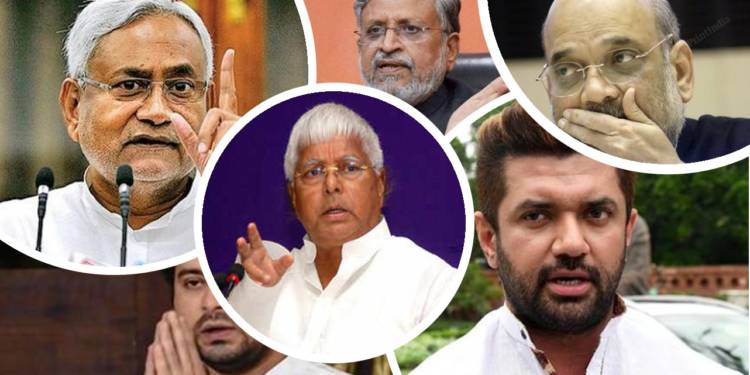The preparations of Bihar Assembly Elections 2020, which are just round the corner, are underway without much fanfare this time. Given the fact, BJP has decided to go ahead with its old allies- JD(U) and LJP. The party has decided to play under the leadership of the same person and the outcome is expected to be no different.
Any political analyst would tell you that Bihar’s political (read caste) equations are such that if two major parties come together, the third is bound to lose. Apart from BJP, all the regional parties JD(U), RJD, LJP and many others operate on vote bank model with few particular castes being loyal to a certain leader of the party (Muslims and Yadavs vote for RJD; Kurmi and some Mahadalits vote for JD (U); upper castes vote for BJP; Paswans vote for LJP).
No matter with whom the top command allies, the people of that particular caste would vote for their party or leader and therefore, whenever two big parties are together, they are bound to sweep elections- as visible since 2005. So, if three parties go separately in elections then there would be a hung assembly and if two come together, they would win the election.
But, the situation might change this time due to the huge anti-incumbency against Nitish Kumar. Kumar has been a incumbent leader of Bihar– with a small period of disruption with Manjhi but he was controlling that government too– for the last 15 years, but, still, Bihar remains at the bottom in state rankings on almost all socio-economic indicators. Despite 15 years of uninterrupted rule, Nitish Kumar focused only on media management to craft an image of ‘Sushanshan Babu’ and did very little to change the fundamental nature of the state’s political economy.
This year the people of Bihar suffered most. First, due to the migrant crisis since Bihar’s economy is largely dependent on remittances sent by migrant labourers who work in distant states. But, with the eruption of COVID, they returned to their homes with income plummeting near zero. And Second, due to floods. Nitish Kumar did little to support the migrant labourers and bringing them back home. This angered the poor labourers whose frustration and helplessness was visible in many viral videos. Recent floods have exposed the mismanagement of the state administration and the overall failures of Nitish Kumar in administration as well as in providing socio-economic welfare.
Therefore, the people of Bihar might just vote against Nitish Kumar’s party- JD(U)- and bring its tally very low. But even in such a situation, BJP will remain a dominant force given the fact it won 31 seats in the 2014 general election when JD(U) fought against BJP and 40 per cent vote share along with its allies. Even in the 2015 assembly election- when JD(U) fought with RJD- BJP and its allies won 35 per cent of votes and 58 seats.
The popularity of the Prime Minister is more than ever throughout the country, and with the construction of Ram Mandir, the party has only consolidated its vote bank in the state. The voters of BJP will vote for the party but not for Nitish Kumar. While Nitish Kumar’s vote is as transferable as that of Mayawati, BJP’s voter base is not, especially at a time when Nitish proved to be the worst CM in the country.
Therefore, suppose BJP with its other allies, and JD(U) fight on the equal number of seats- that is 122- and JD(U) ends up being a smaller player in a hung assembly situation, then the alliance would still be able to form the government with smaller players and independents, but Nitish Kumar would have no moral or mathematical authority to claim over CMs chair. Given the fact that Nitish Kumar is swollen with pride, he would not lead an alliance in which he is not at the driving seat.
In such a situation, the alliance would come to power but with a BJP CM who would probably not carry the baggage of socialism and secularism like Nitish Kumar. Therefore, a hung assembly with BJP and its non-JD(U) allies having more seats than JD(U) would be the best situation to get a BJP CM in the state.


































